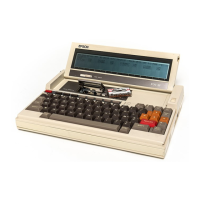Having typed them in and saved them under the file names SSA VE.COM and
SLOAD.COM, proceed
as
follows
to
use them with BASIC:
i)
Execute SSA VE
on
the
CP
1M
command line. The SSA VE program
will
relocate the appropriate part
of
the program
to
the memory locations be-
ginning with B400H.
ii) Execute SLOAD
on
the
CP
1M
command line. The SLOAD program will
relocate the appropriate part
of
the program
to
the memory locations be-
ginning with B200H.
iii) Enter BASIC using the command:
BASIC
1M:
&HB200
This will load BASIC but with the upper memory limit for variables set to
B200H, thus protecting the two loaded
proirams.
iv) Load and RUN the following program as an example:
10
SCREEN 3,0,0 :CLS
20 LINE (0,0) - (479,63)"B
30
LINE (0,0) - (479,63)
40
LINE (479,0) - (0,63)
50
S = &HB400: L = &HB200: REM start addresses to
Save
and Load
60
CALL S
70
CLS: LOCATE
27,1
: PRINT
"The
screen has been saved."
80
LOCATE 24,5 : PRINT "Press any key to load the screen."
90 IF INKEY$
= " "
THEN
80
100
CLS
110
CALL L
120
LOCATE 24,5 : PRINT
"Press
any key to exit"
130
IF INKEY$ = " " THEN
130
140
SCREEN 0
H-17
Appendix I
CP/M
ERRORS
AND
MESSAGES
When using
CP
1M
and the associated utilities, many possible errors can occur.
Messages can come from different sources. They can be dislayed when there
are errors in calls
to
the Basic Disk Operating System (BDOS).
CP
1M
also dis-
plays errors when there are errors in command lines. The following list
of
error
messages and sources
of
error covers errors in
CP
1M
and the standard utili-
ties. Some
of
these utilities may only be supplied
on
disk, but the error mes-
sages are presented as a single table
to
cover all these cases. Other application
programs and the TERM and FILINK utility programs have their own error
messages. Please consult the sections in this manual approprite to these utili-
ties
or
the manual provided with the application program, when using such
programs.
Message
?
ABORTED
ASM Error Messages
Meaning
This message has four possible meanings:
1)
DDT
does not understand the assembly language
instruction.
2)
The
file
cannot be opened.
3)
A checksum error occurred in a HEX file.
4)
The assembler/disassembler was overlayed.
You stopped a
PIP
operation by pressing a key.
D Data error: data statement element cannot be plac-
ed in specified data area.
E Expression error: expression cannot be evaluated
during assembly.
L Label error: label cannot appear in this context
(might be duplicate label).
N Not implemented: unimplemented features, such
as macros, are trapped.
o Overflow: expression
is
too complex
to
evaluate.
P Phase error: label value changes on two passes
through assembly.
R Register error: the value specified as a register
is
in-
compatible with the code.
S Syntax error: improperly formed expression.
1-1

